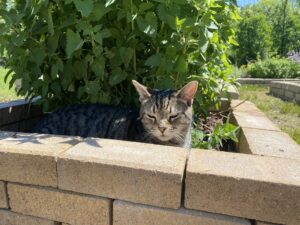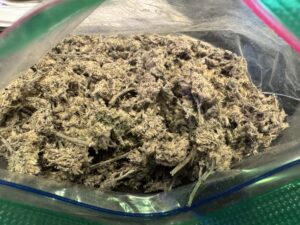Growing catnip (cataria nepeta) in a garden or landscape offers several benefits beyond just entertaining cats. This low-growing, loosely branching herb complements any mulched bed or tended area. It’s one of the easiest herbs to maintain, tolerates a variety of soils, and as a perennial, it returns year after year with minimal effort by the gardener.

Note that catnip and catmint are not the same plant, although they do belong to the same family. Catnip originated in Europe and has been traditionally used as an herbal medicine for calming the nerves and decreasing restlessness.
You can grow catnip anywhere in North America, either in-ground or in a container. It won’t take over the area you plant it in, unlike some herbs such as lemon balm and mint. While you might want to keep it contained to a small area, you won’t damage the plant by trimming it back. Even if you let it grow naturally, it won’t get more than a couple of feet tall.
Some garden centers and box stores will sell small potted catnip plants. You’ll find it merchandised with the potted herbs if they have it. Don’t waste your money on a large potted catnip plant, as a typical 3.5″ x 3.5″ nursery pot will grow into the same size within a month or two anyway.
You can also buy seeds if you prefer to go this route, but make sure you’re buying catnip, and not catmint or cat grass (although this is a plant you should also consider, as it thrives in a sunny window and will provide enrichment and entertainment for your cat). Plant the seeds a 1/4″ deep in typical potting soil. I recommend soaking the seeds in water for 24 hours before planting, as this softens the seed coat and helps with germination. Keep the soil warm and moist, and you should see germination in 7 to 14 days. While established adult catnip plants are quite hardy, you should harden off a young seedling by gradually exposing it to outdoor conditions (sun, wind, and rain) so they can adjust to the change. This prevents shock and promotes healthy growth.
Catnip transplants very well, so you can simply divide the roots of a friend’s established plant if you have this option. Regular watering is crucial until the transplant establishes new roots in your garden or container. While digging up part of the donor plant is the fastest way to create a vigorous new catnip shrub, leaf tip cutting is another route to creating your own plant. Catnip propagation is a great place to start if you want to learn this technique because it’s one of the hardiest perennial herbs thanks to its mint family credentials. Just take a 6-inch or so cutting from a healthy plant (ideally in spring or early summer so your new plant has lower water needs and time to establish itself), and cut the stem at a 45-degree angle just below a leaf node. Remove the leaves from the bottom half of the cutting and place it in a container of water (a glass jar works great for this – just try to change the water every day) or moist potting soil. You need to keep the soil moist if you’re doing this option, otherwise the cutting will fail to send out new roots and die shortly thereafter. Transplant the cutting once you see roots and new leaf growth on the stem.
Here are several reasons you should consider some space for catnip in your garden or landscape:
1. Higher Potency Than What You Can Buy in a Pet Store

Let’s be honest here; the only reason most of us know that catnip exists is because we like to watch our cats enjoy their little kitty high. Fresh catnip is more potent, and therefore, more enjoyable for most cats than the dried catnip from the pet store. A compound called nepetalactone found in the leaves and stems is what makes it irresistible to our feline friends. Nepetalactone increases levels of beta-endorphins, which makes cats feel good.
Most people report that it makes their cats playful, relaxed, or euphoric, providing them with mental stimulation and entertainment. Here’s a link to a great refillable catnip ball toy that doubles as a scratcher.
The levels of the volatile oil responsible for these effects are higher in fresh catnip than when it is dried, so you may want to grow your own and offer it to your cat if it hasn’t shown interest in dry catnip in the past. As a side note, did you know that catnip sensitivity is hereditary? Interestingly, an estimated 50% of cats have no, or little, reaction to it.
Even if you don’t own a cat, you surely have a friend or neighbor who does. Cut off a few whole stems and bring them over the next time – it costs you nothing and shows your thoughtfulness and consideration by acknowledging something they care deeply about.
The nepetalactone is concentrated in the leaves and flower buds, so don’t bother saving the stems. The levels of this oil are highest when the plant is flowering, but don’t hesitate to pick some any time of the year. The oil gradually loses its potency once it’s harvested, but it should still illicit a response from your cats for several months in dried form.
2. Safety Assurance
I often question the conditions in which dried herbs (including those meant to be added to human foods) are stored compared to the treatment fresh produce receives. Food handling standards for dry bulk ingredients, particularly if they are for animal feed, are far less stringent than for ingredients that require refrigeration or freezing. Depending on the source country, there are few, or no, standards for what can be sprayed on a plant if it isn’t labeled for human consumption.

If my cats are consuming it, I want to know it’s going to be safe for them. One of the best things about growing more of your own vegetables, fruits, and herbs is that you have 100% assurance of what, if any, chemicals (organic or otherwise) you have applied. I feel at ease pinching off a stem of catnip from a plant from my garden and giving it to our cats without having to wonder if it came from an overseas facility that will be featured on the evening news as ground zero for the latest pet food contamination tragedy.
3. Tea for Humans
Catnip tea is nowhere near the nutritional powerhouse as green tea, but it is still rich in antioxidants (specifically, flavonoids) and phenolic acids. The former have been proven to prevent cell damage caused by free radicals. Phenolic acids also possess some antioxidants and boast anti-inflammatory properties of their own.
I drink tea -mostly a Sencha/Matcha green tea blend- every day. Catnip tea isn’t one of the more popular herbals and isn’t one that I drink frequently, but I don’t think it would be difficult to get used to, either. It has as a woodsy, grassy taste, but the addition of lemon juice or honey results in a brighter, more well-rounded flavor. It’s as easy to make as any herbal tea – just steep two teaspoons of dried leaves in one cup of boiling water and enjoy. Here’s a link to the most popular tea infuser for loose tea on Amazon. I like this two-pack for its economy, simplicity, and build quality.
4. Attract Bees and Other Pollinators
Bees, butterflies, and other beneficial pollinating insects (moths, flies, beetles, and more) are attracted to the flowers that bloom on catnip in late spring and last until fall.
Just about everyone is aware of that the population of honey bees has been in decline over the past several decades. This has mostly been due to increased use of pesticides containing neonicotinoids, destruction of habitat through development, the application of selective herbicides (think “weed-and-feed”) on existing lawns, competition with invasive plants and bees, as well as new and emerging diseases. Many other species of insects beyond honeybees, namely bumblebees and butterflies, carry the burden of pollinating the vegetables, fruits, and flowers in our gardens and landscapes, but a gardener should strive to keep the local population of honeybees alive and well-fed. Catnip should rate at least a small home in every garden solely for its ability to attract these insects.

In case you’re wondering if stray cats will be attracted to landscaped beds with catnip in them, the answer is – yes. You’ll probably be alright even if you have cats that roam the area if you have just a few plants.
5. Aesthetics and Hardiness
I would still have catnip in my landscape even if I never harvested any of it. It’s just an all-around nice looking perennial herb that stays fairly small and doesn’t require maintenance. Pests don’t bother it, and no animals (including deer) are going to eat it. Also, while catnip does belong to the mint family, it won’t spread like mint because it doesn’t send out runners underground. It will shed seeds once the buds are dried late in the year, but you can either mulch around the adult catnip to prevent germination or easily pull these new plants in the spring when they come up.
Plants in the mint family are known for their drought resistance. While this isn’t the “survive a Mad Max-style apocalypse” peppermint or spearmint, catnip’s needs in the garden are minimal. I didn’t need to water my catnip at all during the intense drought we had in the late summer and fall of 2024 here in central Ohio, even though it was in a raised bed and in full sun.
Catnip is considered a hardy perennial and can withstand a hard frost before it starts to die back for the year. A best practice is to cut it back at the end of the season and cover it with mulch. It should come back without a problem in the spring if this is all you do. Alternatively, you can cut off some roots and plant it inside in pots to get through the winter if you want it to take off earlier in the spring when you plant it back out in the garden.
If you enjoyed this article or found it helpful, I’d truly appreciate it if you shared it with a friend! Also, if you’re interested in learning about some of the items I have found most useful in my own gardening and cooking, you can check them out on my Product Reviews page. As an Amazon Associate, I earn from qualifying purchases, which helps keep Richwood Gardens growing.
Every product I review is something I personally own or have used—because I’d never recommend something I wouldn’t spend my own money on. Your support means the world to me, and it allows me to keep sharing helpful content with you. Thank you for being a part of the Richwood Gardens community!


